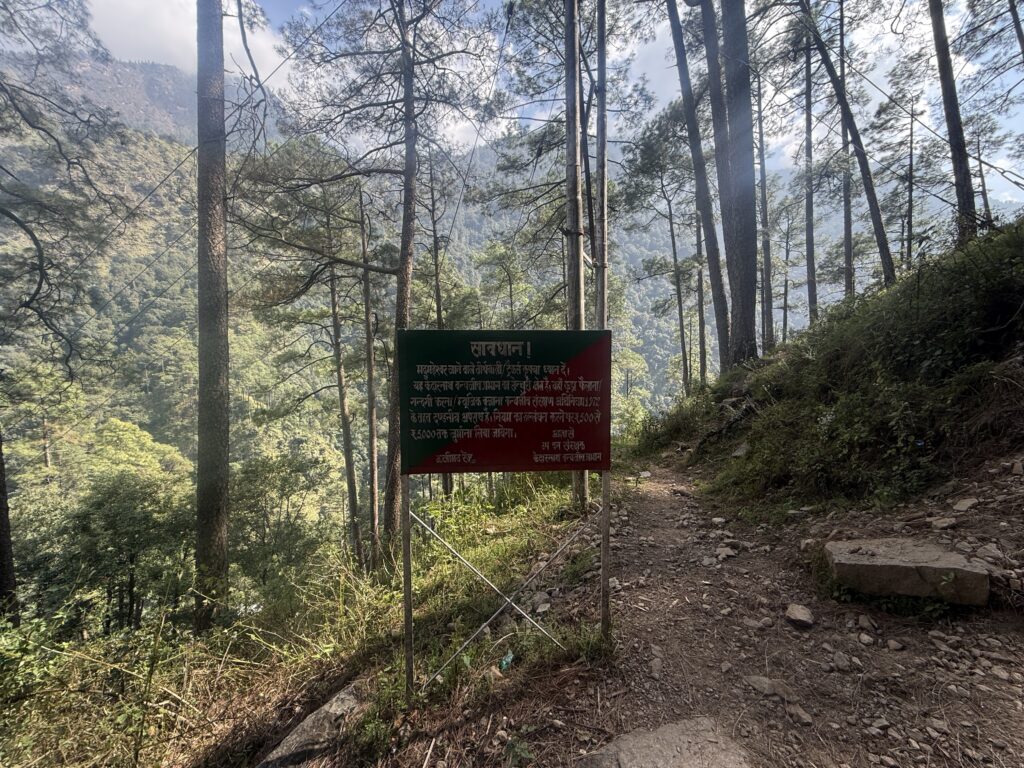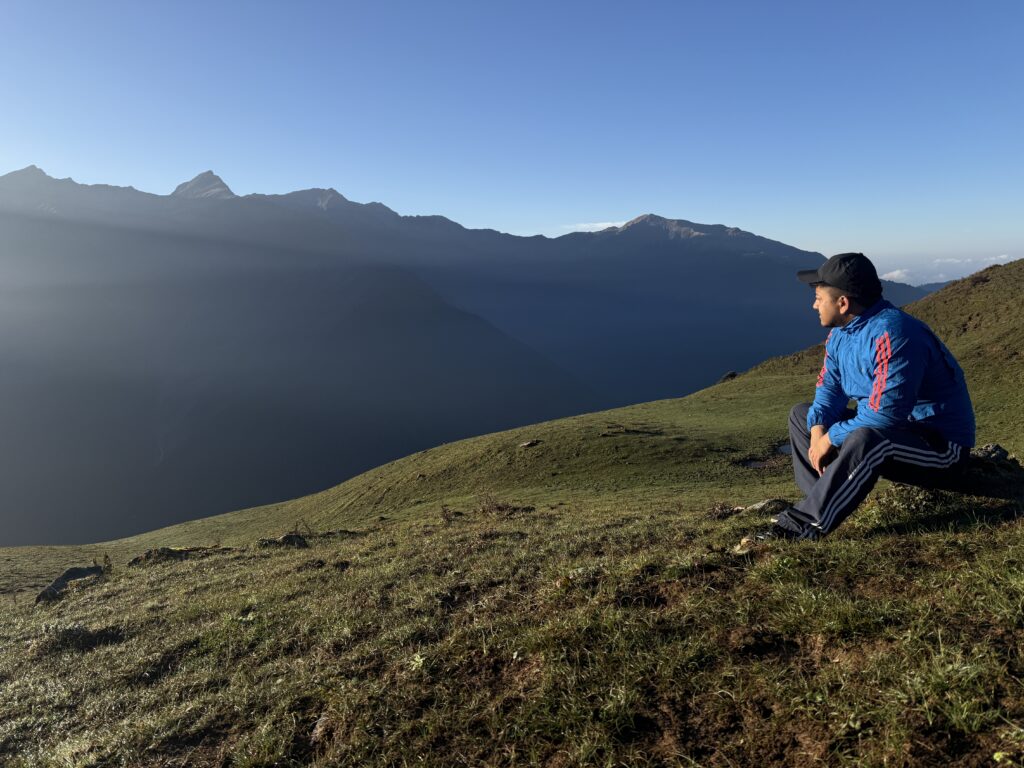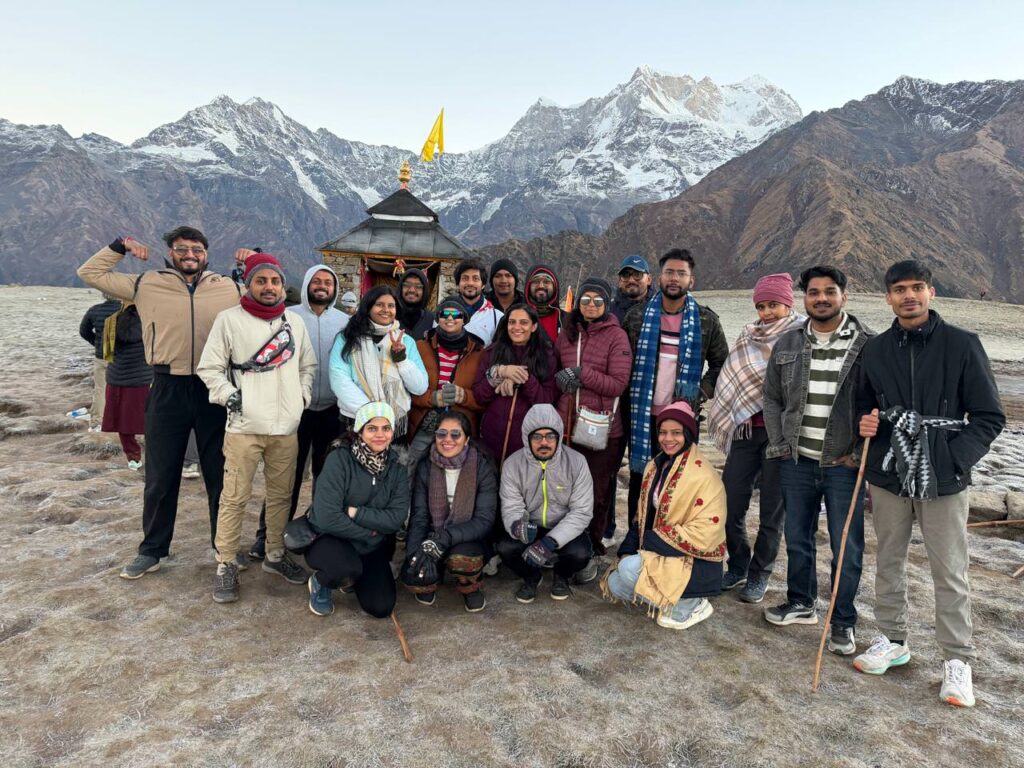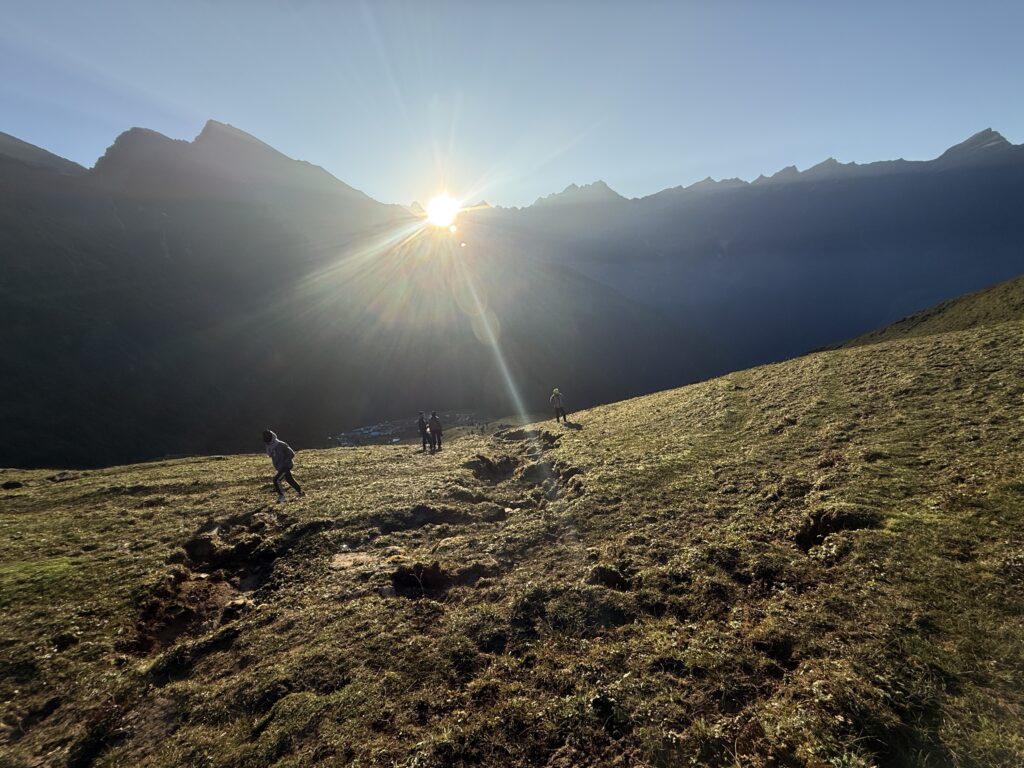Best Time to Visit Madhyamaheshwar Temple for Trekking
Published on November 14, 2025
The journey to Madmaheshwar is not just a trek—it is a soulful walk into one of the most peaceful corners of the Himalayas. Nestled in the remote folds of Uttarakhand, the Madhyamaheshwar temple stands as a serene reminder of ancient devotion and nature’s untouched beauty. As one of the revered shrines of the Panch Kedar Madhyamaheshwar, this sacred destination attracts both spiritual seekers and trekking enthusiasts who want to experience a blend of mythology, mountain culture, and raw Himalayan charm.
The trail winds through dense forests, sparkling streams, and traditional villages, offering a trekking experience that feels intimate and deeply spiritual. Whether you come for the legends, the landscapes, or the sense of calm that surrounds the temple, the Madmaheshwar trek leaves you with memories that stay long after the journey ends.

Seasonal Overview: What Each Time of Year Offers
The Madmaheshwar Trek Route is one of those Himalayan journeys that changes mood and beauty with every season, offering a different experience to every traveler. Before planning your pilgrimage or adventure, it’s important to understand how the landscape, weather, and trail conditions evolve throughout the year. This not only ensures safety but also helps you choose the best time to visit Madmaheshwar based on what you want from the journey.
Spring (March–April):
The forests wake up with blooming rhododendrons and fresh greenery. The trails are colorful, temperatures are mild, and the trek route feels refreshing and full of life.
Summer (May–June):
The most popular trekking season, offering pleasant weather, clear skies, and comfortable walking conditions. This is considered the best time to visit Madmaheshwar for first-time trekkers.
Monsoon (July–September):
The valley turns lush and magical, but rains can make the paths slippery. While the beauty is unmatched, only experienced trekkers should attempt the Madmaheshwar trek route during this time.
Autumn (October–November):
Crystal-clear mountain views, golden forests, and stable weather make this another ideal window. Many trekkers prefer autumn for its peaceful trails and crisp air.
Winter (December–February):
Heavy snowfall blocks the upper trails, and the temple region becomes difficult to access. Only the lower winter shrine remains open. This season is not recommended for the full trek.
Each season brings its own charm, but choosing wisely ensures you enjoy the journey safely and fully.

Summer (April–June): The Most Comfortable Trekking Season
Summer is widely considered the most rewarding time to begin your journey toward the sacred shrine of Madmaheshwar. With clear skies, gentle sunshine, and blooming forests, the trail feels welcoming for beginners as well as experienced trekkers. The moderate temperatures make it easier to adjust to the Madhyamaheshwar altitude, which rises to around 3,497 meters—high enough to offer majestic Himalayan views yet pleasant enough for comfortable trekking.
During these months, streams flow steadily, village paths are lively, and the entire route feels vibrant with nature’s freshness. If you’re wondering How to Reach Madhyamaheshwar during summer, this season offers the smoothest travel experience. Roads remain open, public transport is frequent, and trekking paths are clear of snow, making your journey safer and more enjoyable.
Whether you're visiting for devotion, photography, or adventure, the April–June window ensures that every moment on the trail feels relaxed, scenic, and spiritually uplifting.
Monsoon (July–September): Beauty with Challenges
The monsoon season paints the Madmaheshwar valley in the deepest shades of green, turning the trek into a breathtaking experience filled with misty forests, flowing waterfalls, and cloud-wrapped mountains. However, this beauty comes with challenges. Frequent rain can make the trail slippery, river crossings unpredictable, and visibility low—making this period suitable only for experienced trekkers who are comfortable navigating difficult terrain.
Although the Madmaheshwar Opening Dates usually fall in late April or early May, the temple remains accessible during the monsoon as long as weather conditions allow. But trekkers must stay updated on local advisories, as landslides and road closures are common in this season.
Those planning to visit should also keep an eye on Madmaheshwar darshan timings, as heavy rains can occasionally affect temple schedules or restrict movement around the shrine. Still, for nature lovers seeking solitude and raw Himalayan charm, monsoon brings a magical calmness to the valley that few other seasons can match.

Autumn (October–November): Crystal-Clear Views and Ideal Weather
Autumn is one of the most rewarding seasons to explore Madmaheshwar, offering sharp mountain views, crisp air, and peaceful trails. As the monsoon clouds fade, the Himalayas emerge in their full glory, making this period perfect for capturing stunning Madhyamaheshwar photos. The golden forests, deep blue skies, and snow-dusted peaks create a picture-perfect backdrop at every turn.
Trekking during this season is also easier and safer, thanks to stable weather and well-defined paths. If you like planning your journey visually, checking a Madhyamaheshwar map before the trek helps you understand the terrain, route gradients, and scenic spots you’ll encounter along the way. Autumn’s clear atmosphere makes every viewpoint stand out, allowing trekkers to enjoy panoramic landscapes without fog or rainfall interruptions.
For those seeking serenity, spirituality, and the most photogenic version of the Himalayas, October to November is truly an ideal time to visit Madmaheshwar.
Winter (December–March): Snowy Trails and Temple Accessibility
Winter transforms the Madmaheshwar valley into a silent world of snow, making it one of the most enchanting yet challenging times of the year. The upper trail to the temple becomes completely snow-covered, and due to heavy snowfall, the main shrine remains inaccessible. During this period, devotees continue their Madmaheshwar pilgrimage by visiting the winter abode of the deity at Ukhimath, where rituals and worship are carried out with the same devotion.
Before planning a cold-season journey, it’s important to understand Madhyamaheshwar Weather in winter—temperatures often drop below freezing, icy winds sweep across the region, and paths remain blocked for weeks. This season is not suitable for trekking, but it is ideal for those who wish to experience the spiritual essence of the yatra in a quieter, more serene form.
Travel planners often offer a simplified Madmaheshwar yatra package for winter visitors, focusing on road travel, temple visits at Ukhimath, and nearby spiritual sites. Although the trek itself is not possible, the winter yatra still carries the same devotion and purity that define the Panch Kedar tradition.

Best Month for the Madhyamaheshwar Temple Trek
Choosing the right month to visit Madmaheshwar can elevate your entire trekking experience. Weather, trail conditions, and visibility change dramatically across the year, so picking the ideal time ensures you enjoy both the spiritual and scenic essence of the journey. Whether you're seeking peaceful temple moments or stunning Himalayan panoramas, here is the month-wise guide to the Madhyamaheshwar temple trek, especially for those following the sacred Panch Kedar Madhyamaheshwar route.
May: Fresh Trails and Perfect Weather
May is one of the best months to trek to Madmaheshwar. The forests come alive with new leaves and blooming flowers, the streams are full, and the weather is cool and stable. Views of Chaukhamba and surrounding peaks are exceptionally clear, making your visit to the Madhyamaheshwar temple deeply rewarding. Many pilgrims prefer May as the true beginning of their Panch Kedar Madhyamaheshwar journey.
June: Comfortable Temperatures and Lively Landscapes
June continues the pleasant summer conditions, with warm days and refreshing evenings. The trail is lively, and the natural beauty peaks during this month. Clear skies and light breezes make the climb to Madmaheshwar comfortable. If you want a smooth trekking experience paired with spiritual calm at the Madhyamaheshwar temple, June is an excellent choice on the Panch Kedar Madhyamaheshwar route.
September: Green Valleys and Post-Monsoon Clarity
After the monsoon rains retreat, September unveils sparkling green forests, waterfalls, and freshly washed landscapes. While the trail may be slightly moist, the beauty of the Madmaheshwar valley is unmatched. Many devotees choose September for its spiritual purity and natural freshness, making it a rejuvenating month to visit the Madhyamaheshwar temple while continuing their Panch Kedar Madhyamaheshwar pilgrimage.
October: Crystal Skies and the Best Himalayan Views
October is often regarded as the finest month for the Madhyamaheshwar trek. The skies are at their clearest, the air is cool and crisp, and the forests begin turning golden. This month offers the most stunning views of the Chaukhamba massif and surrounding peaks. Visiting the Madhyamaheshwar temple in October feels serene and visually spectacular—perfect for trekkers and photographers completing the Panch Kedar Madhyamaheshwar route.
November: Serene Trails and Peaceful Pilgrimage
November brings a quiet charm to the region. With fewer crowds and calm weather early in the month, the trek to Madmaheshwar becomes a peaceful experience. The valley takes on a winter-like stillness, making your darshan at the Madhyamaheshwar temple feel intimate and deeply spiritual. It’s a wonderful time for devotees who prefer solitude during their Panch Kedar Madhyamaheshwar journey.
| Month | Trekking & Weather Conditions | Why Visit This Month |
|---|---|---|
| April | Snow melts, trails open, cool weather | Ideal start of the season; the Madhyamaheshwar temple opens with spiritual energy and peaceful surroundings. |
| May | Pleasant days, clear views, stable conditions | Perfect for families and pilgrims exploring Panch Kedar Madhyamaheshwar without harsh weather. |
| June | Warm days, moderate evenings, lush valleys | Beautiful landscapes; great for photography and nature lovers trekking to Madmaheshwar. |
| July | Rain begins; slippery trails | Only for experienced trekkers; the forests look magical but require caution. |
| August | Peak monsoon; landslide-prone areas | Travel not recommended; trails to Madhyamaheshwar temple remain risky due to heavy rainfall. |
| September | Rain fades; fresh greenery | One of the best months—vibrant meadows and refreshing climate after monsoon. |
| October | Clear skies, stunning Himalayan views | Perfect for spiritual seekers visiting Panch Kedar Madhyamaheshwar with crystal-clear mountain scenery. |
| November | Cold but stable; temple closes by mid-month | Last chance to visit before winter closure; peaceful and crowd-free trekking. |
| December | Heavy snowfall, trail closures | Trek accessible only up to Gaundhar; main shrine inaccessible. |
| January | Deep winter, extreme snow | Not suitable for the trek; region covered in thick snow blankets. |
| February | Harsh winter persists | Trek route remains closed; only symbolic worship done. |
| March | Snow starts melting slowly | Early preparation month; trekking may open toward late March depending on snow conditions. |

Weather Conditions You Should Expect on the Trek
The Madhyamaheshwar trail is known for its constantly shifting moods, and your experience can change dramatically with altitude and season. As you move from the dense forests of Ransi and Gaundhar to the high meadows near the temple, the weather transforms from mild and pleasant to crisp and chilly.
1. Cool Mornings and Pleasant Days (April–June)
During spring and early summer, trekkers can expect fresh mountain air, moderate sunshine, and clear skies. Daytime temperatures stay comfortable, making the ascent calm and enjoyable. Light woollens are enough, but evenings can still get surprisingly cold.
2. Sudden Showers and Misty Forests (July–August)
Monsoon brings unpredictable rain, slippery stones, and low visibility. Fog rolls into the valley quickly, creating mystical landscapes but demanding extra caution. Leeches and muddy sections are common, so waterproof gear becomes essential.
3. Fresh Greenery and Crisp Winds (September–October)
Post-monsoon is one of the most stable periods on the trek. Days remain cool, skies stay clear, and the newly washed forests glow with colour. Nights start turning cold, especially near the temple, so layered clothing becomes important.
4. Cold Evenings and Early Snowfall (November)
As winter approaches, temperatures drop sharply. The wind becomes dry, and frost begins forming on the upper trails. This is the final window of safe trekking before heavy snow arrives.
5. Extreme Snow and Closed Trails (December–March)
Winter transforms the entire region into a snowbound zone. Temperatures often fall below freezing, and the trail to Madhyamaheshwar temple closes due to high snow accumulation. Only the lower areas remain accessible, and trekking is generally not recommended.
In short, expect weather that changes quickly, rewards you with breathtaking views, and keeps you alert at every step. Proper preparation is the key to enjoying this unforgettable Himalayan journey.

How Season Affects Trek Difficulty and Trail Conditions
The Madhyamaheshwar trek is a journey where the terrain, weather, and difficulty shift with every season. Each time of year leaves its own signature on the trail, shaping both the beauty and the challenges you’ll face.
1. Summer (April–June): Easiest and Most Stable Trails
Summer offers the most comfortable trekking experience. The paths are dry, the forest routes are clear, and there’s minimal risk of slipping. Daytime temperatures stay pleasant, making the climb steady and manageable. Even beginners find this season friendly, with only the final ascent feeling moderately tiring.
2. Monsoon (July–September): The Most Challenging Season
Monsoon dramatically changes the trek’s difficulty. Heavy rain makes the stone paths slippery, and mud accumulates on steep stretches. Landslides, flowing streams, and poor visibility can slow your pace. This season is best suited for experienced trekkers who can handle unpredictable terrain and sudden weather shifts.
3. Autumn (October–November): Clear Views, Moderate Difficulty
Post-monsoon, the landscape turns calm and crisp. The trails are largely stable, though the stone steps can be wet in shaded sections. The thinning air near the temple and colder nights add mild difficulty, but the breathtaking views compensate for every extra effort. This season is ideal for trekkers who want a balanced blend of comfort and adventure.
4. Early Winter (November–December): Increasingly Tough Conditions
As temperatures drop, the trail becomes harder. Frost forms on rocks, winds turn sharp, and evenings become freezing cold. The route near the temple can get slippery, demanding more caution and proper winter gear.
5. Deep Winter (December–March): Snowbound and Difficult
Heavy snowfall covers most of the Madhyamaheshwar trail, making it inaccessible beyond certain points. Snowy sections hide the trail, increase slipping risk, and demand advanced trekking skills. This period is generally avoided unless you are on a specialised winter expedition.

Wildlife, Flora, and Photography Opportunities by Season
The Madhyamaheshwar valley is a living canvas that changes every season. As you walk toward the sacred shrine during your Madmaheshwar pilgrimage, you’ll notice how wildlife, forests, and mountain light shift with the months—creating unique photography moments and unforgettable memories. Whether you're staying in basic Madhyamaheshwar accommodation or simple hotels near Madmaheshwar, each season paints the trail differently.
1. Summer (April–June): Blooming Forests and Active Wildlife
Flora:
Summer turns the entire trek route into bright shades of green. Rhododendrons fade, giving way to new wildflowers. Oak, pine, and deodar forests glow with fresh leaves, making this the most vibrant time for nature lovers.
Wildlife:
Birds like Himalayan Monal, Woodpeckers, and Flycatchers are active. Early mornings may reveal Himalayan musk deer or playful langurs deep inside the forest sections.
Photography:
-
Rich green landscapes
-
Clear blue skies
-
Sunrise photos near temple meadows
-
Perfect lighting for forest portraits
Summer is ideal for photographers who love color and natural brightness.
2. Monsoon (July–September): Lush Jungles and Dramatic Landscapes
Flora:
Monsoon is peak greenery. Moss-coated stones, dripping ferns, and thick leafy canopies dominate the trail. Waterfalls spring to life along the Madmaheshwar route, turning the valley into a fresh, aromatic world.
Wildlife:
Animals come out cautiously, but birdlife remains delightful. Small reptile activity increases, and butterflies appear in huge numbers.
Photography:
-
Waterfall shots
-
Mist-filled forest frames
-
Moody mountain landscapes
-
Close-ups of wet leaves, mushrooms, and monsoon flowers
The monsoon atmosphere adds depth and drama—perfect for artistic photography.
3. Autumn (October–November): Golden Light and Crystal-Clear Vistas
Flora:
Autumn dries the excess monsoon moisture and reveals golden grasslands, sharp ridgelines, and perfectly visible mountain peaks. Trees shift to warm amber tones.
Wildlife:
Migration season for many birds. You may spot Himalayan Griffons, Eagles, and various alpine birds soaring in the clear skies.
Photography:
-
Panoramic shots of Chaukhamba peak
-
Sharp visibility for long-distance mountain shots
-
Golden-hour hues around the temple
-
Star photography from open meadows
Autumn is arguably the best time for professional-level photography.
4. Winter (December–March): Snow Landscapes and Silent Wilderness
Flora:
Winter quiets the valley. Snow covers higher sections near the Madhyamaheshwar temple, turning meadows into white carpets. Trees look sculpted and dramatic against the sky.
Wildlife:
Wildlife sightings drop, but you may see fresh animal tracks in the snow—bark deer, foxes, and sometimes Himalayan pheasants.
Photography:
-
Snow-covered trails
-
Frozen streams
-
Soft winter light perfect for portraits
-
Dramatic white landscapes
Winter offers rare, peaceful frames that feel untouched and pure.

Tips for Planning Your Trip According to the Season
Planning your Madhyamaheshwar journey becomes much easier when you shape your itinerary around the changing moods of the mountains. Each season affects not just the trail but also what you can see, experience, and photograph. Whether you’re exploring Madhyamaheshwar wildlife / nature, searching for the best Madmaheshwar viewpoints, or absorbing the deep Madhyamaheshwar cultural significance, choosing the right season ensures a richer pilgrimage.
1. Summer (April–June): Ideal for Scenic Exploration
Summer is the safest and most comfortable season, making it perfect for first-time trekkers. Clear trails allow you to explore forest sections where Madhyamaheshwar wildlife / nature flourishes. Plan early morning hikes to reach high Madmaheshwar viewpoints when the skies are clear and the mountain light is soft. This is also the best time to sit with locals and learn about the Madhyamaheshwar cultural significance connected to legends of the Panch Kedar.
2. Monsoon (July–September): Travel With Flexibility
If you choose monsoon, build extra buffer days into your itinerary. Trails become slippery, and sudden rain can slow your pace. However, monsoon rewards you with thick forests, mossy stones, and flowing streams—perfect for nature enthusiasts. Carry waterproof covers for your gear and keep your schedule open so you can safely explore natural corners rich in Madhyamaheshwar wildlife / nature.
3. Autumn (October–November): Perfect for Photography and Learning
Autumn offers the clearest skies and the sharpest views. This is the time to capture wide Himalayan frames from iconic Madmaheshwar viewpoints. The landscape shifts to warm colors, giving you a golden canvas for photography. You’ll also find locals more relaxed after the monsoon, making it easier to interact and understand the deeper Madhyamaheshwar cultural significance of the temple and valley.
4. Winter (December–March): Plan for Limited Access
During winter, snowfall can block the upper trail, so always check accessibility before planning. Lower stretches remain open and offer peaceful landscapes, ideal for travellers seeking silence and untouched nature. While Madhyamaheshwar wildlife / nature becomes harder to spot, winter light is magical for capturing snow-covered ridges and frozen frames. Carry proper winter gear and ensure you have warm stays arranged in advance.

Conclusion: Choosing the Perfect Time for a Safe and Blissful Trek
Choosing the right season for your journey to Madmaheshwar can transform your pilgrimage from a simple trek into a deeply fulfilling Himalayan experience. Whether you walk through blooming summer forests, crisp autumn ridgelines, or peaceful winter trails, every season highlights a different shade of beauty around the Madhyamaheshwar Temple. Planning your trip with awareness of weather, trail conditions, and your own comfort ensures that the experience remains safe, smooth, and soulful.
As one of the revered shrines of the Panch Kedar Madhyamaheshwar, this trek carries both natural charm and profound spiritual weight. When you travel at the right time—when the mountains welcome you with clear paths, calm skies, and gentle winds—you not only enjoy the scenery but also connect more deeply with the divinity that flows through the valley. Ultimately, the perfect time is the moment when your mind, body, and the Himalayas move in harmony, guiding you toward a journey filled with peace, devotion, and bliss.
Frequently Asked Questions:
1. What is the best time to visit the Madhyamaheshwar temple?
The best time to visit the Madhyamaheshwar temple is from May to June and September to November, when the weather is stable, skies are clear, and the trail is safest for trekking.
2. How difficult is the Madmaheshwar trek?
The Madmaheshwar trek is considered moderate, with a steady ascent through forests and meadows. Difficulty increases slightly during early winter and becomes challenging in the monsoon.
3. What makes Panch Kedar Madhyamaheshwar spiritually special?
As a prominent shrine of the Panch Kedar Madhyamaheshwar, the temple is believed to mark the spot where Lord Shiva’s navel appeared. The trek is seen as both a physical journey and a deep spiritual purification.
4. Is accommodation available near Madhyamaheshwar?
Yes, simple Madhyamaheshwar accommodation like guesthouses, homestays, and basic lodges are available in villages like Gaundhar and Bantoli. There are no luxury hotels near the temple.
5. What kind of weather should I expect on the trek?
Weather varies by season: summer offers pleasant temperatures, monsoon brings rain and slippery trails, autumn is crisp and clear, and winter can be snowy and freezing near the shrine.
6. Can beginners attempt the Madmaheshwar trek?
Yes, beginners can comfortably complete the trek in summer and autumn. Proper preparation, hydration, and a slow pace make the climb manageable even for first-time trekkers.
7. What wildlife and nature can I expect to see on the trail?
The region is rich in Madhyamaheshwar wildlife / nature, including birds like Monal, Himalayan Griffon, langurs, musk deer, and dense oak–rhododendron forests.
8. Are there good viewpoints on the route?
Absolutely. Popular Madmaheshwar viewpoints include Kanchani Tal, Budha Madmaheshwar, and the meadow near the main shrine, offering breathtaking views of Chaukhamba and Mandani valley.
9. How does season affect trek difficulty?
Summer and autumn offer the easiest trails. Monsoon makes paths slippery due to rain, while winter adds snow and cold, increasing the difficulty significantly.
10. How should I plan my pilgrimage according to the season?
Choose summer for comfort, monsoon only if you’re experienced, autumn for photography and clear views, and winter for solitude. Aligning your trip with the best conditions enhances the Madmaheshwar experience and deepens your connection with the Madhyamaheshwar temple.



